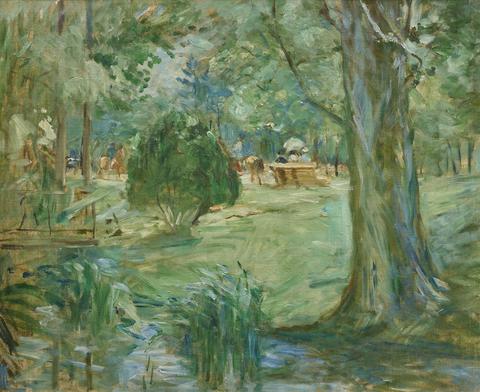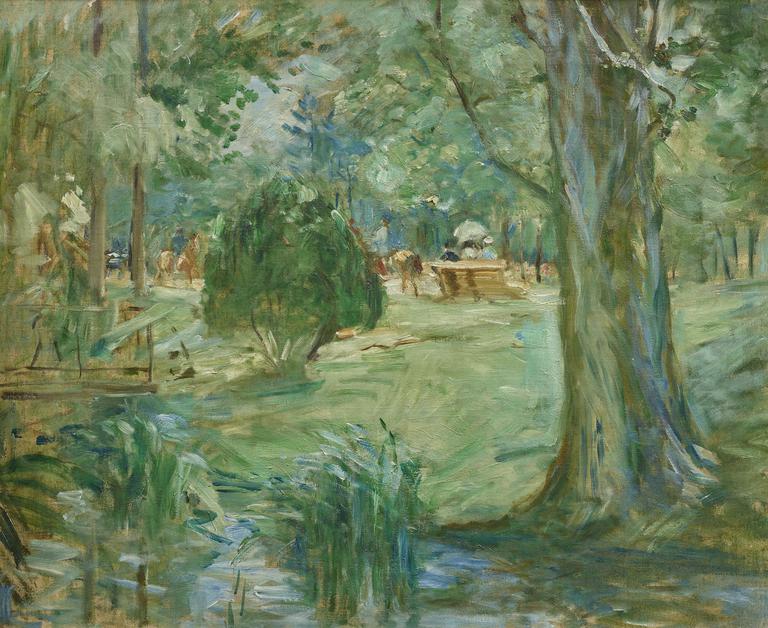
Rivière au Bois de Boulogne
Berthe Morisot (1841 Bourges - 1895 Paris)
1886
Huile sur toile ; 50,4 x 61,2 cm
Provenance :
New York, collection Sara Jane Pansa ; New York, Christie's, 16 mai 1985 ; New York, collection Martin S. Weseley ; New York, Sotheby's, 15 mai 2018.
Exposition :
Madame Eugène Manet, exposition de son œuvre (Paris, galerie Durand-Ruel, 1896, n°114) ; Berthe Morisot (Paris, galerie Druet, 1905, n°17) ; Berthe Morisot Pittrice Impressionista (Milan,Galleria d’Arte Moderna, 2024-2025).
Bibliographie :
Marie-Louise Bataille, Georges Wildenstein, Berthe Morisot, catalogue des peintures, pastels et aquarelles, Paris, Les Beaux-Arts, 1961, no. 202 ; Alain Clairet et al., Berthe Morisot, 1841-1895, catalogue raisonné de l’œuvre peint, Montolivet, CÉRA-nrs, no. 206 (reproduit).
Berthe Morisot, trop tôt disparue à cinquante-quatre ans, contemporaine à quelques mois près de Renoir et de Monet, et qui participa à toutes les expositions du groupe des impressionnistes (sauf celle de 1879), n’a pas encore la place qu’elle mérite dans l’histoire de l’art. Influencée par Corot d’abord, proche de Manet ensuite (y compris familialement puisqu’elle épousa son frère Eugène), de Renoir enfin, par sa facture enlevée, lumineuse, elle est leur égale, discrète, originale.
Ses paysages sont rares, et fréquemment un ou deux personnages en occupent le premier plan. D’où l’intérêt, autant que le charme, de ce tableau plus libre d’une matinée de printemps au Bois de Boulogne. Elle habitait rue de Villejust (aujourd’hui rue Paul Valéry, lequel épousera sa nièce), un immeuble construit par sa belle-famille dans ce quartier juste urbanisé, proche du Bois aménagé « à l’anglaise » sous Napoléon III.
Laissons parler les préfaciers de ses deux premières expositions personnelles, en 1892 chez Boussod-Valadon et en 1896 (un an après son décès) chez Durand-Ruel. Le premier, Gustave Geffroy, qui publie la même année son Histoire de l’impressionnisme, parle de « sa douceur bleue et sa cendre verte ». Le second, rien moins que Stéphane Mallarmé, un ami intime qui sera le tuteur de sa fille Julie, l’évoque peignant « avec furie et nonchalance ». Ce sont très exactement les couleurs et la touche de ce tableau. A peine, dans la furie, distingue-t-on au premier plan une oie, un cygne, une libellule, deux femmes qui s’en vont par la gauche ; mieux, dans la nonchalance, les promeneurs à cheval ou assis sur un banc, au second plan. Au passage, voyez comme la selle brun-rouge avive, au centre de gravité du tableau, toute la toile : un écho de Corot.
Laissons-la parler, elle-même, dans ses Carnets : « Le désir de glorification après ma mort me paraît une ambition démesurée. La mienne se bornerait à vouloir fixer quelque chose de ce qui passe. »
Sarah Jane Pansa, née Sanford, propriétaire du tableau jusqu’en 1985, était la petite-fille de Stephen Sanford, le « roi de la moquette » américain. Sa jeunesse dorée, au côté de sa sœur Gertrude et de son frère Stephen, inspira le film Holiday de Georges Cukor en 1938. Le propriétaire suivant, jusqu’en 2017, fut Martin S. Weseley, grand chirurgien orthopédiste new-yorkais et collectionneur passionné d’art moderne.
